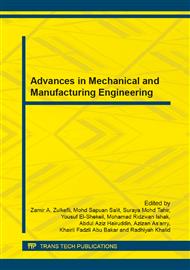p.281
p.287
p.292
p.298
p.304
p.310
p.315
p.323
p.329
Attaining Soot Oxidation Temperature by Inductive Coils Exposed to Electromagnetic Waves
Abstract:
This paper presents the findings in attaining soot oxidation temperature by using carbon steel coils exposed to electromagnetic waves. Soot are unburned carbon product in the exhaust gases during the combustion of diesel fuel, which are subjected to stringent emission regulations due to its harmful properties. The unburned carbon can be oxidised by heating as after-treatment strategy but in order for the oxidation to occur, it would require a temperature of not less than 600°C. In the present work, eight heating elements made from various carbon steel coil sizes were exposed to electromagnetic waves in the microwave oven cavity which heats up the coils to the oxidation temperature. Electromagnetic waves heating utilises electromagnetic radiation to induce electric field in a conductive material that causes the material to be heated. The microwave oven used has a power rating of 1000 W, with a microwave range of 2450 Mhz. Measurement of coils temperature and exposure time to electromagnetic waves were recorded and analysed. The results showed that only the coils with bigger coil loop size, i.e. 20 mm and lowest number of turns, i.e. 10 turns attained the threshold temperature of 600°C, while smaller diameter coil would accelerate the rate of heating. The findings from the research work are significant facts in the future development of in-situ exhaust gas after treatment system in reducing soot emissions.
Info:
Periodical:
Pages:
304-309
Citation:
Online since:
June 2014
Authors:
Price:
Сopyright:
© 2014 Trans Tech Publications Ltd. All Rights Reserved
Share:
Citation:


